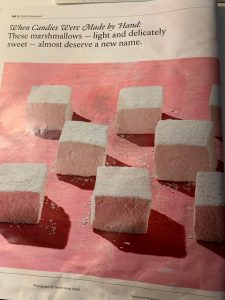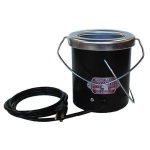I subscribe to the New York Times (All the News That’s Fit to Print) Sunday only. It comes to my driveway and it is my habit to sit in the truck and read for about three hours. In the winter time, the seat is heated and in the summer it is cooled and I can listen to the radio if I want to. It’s actually the best seat in my house. About five weeks ago they published in the magazine section a recipe for making marshmallows at home.
It seems homemade marshmallows are a thing — who knew?? You can flavor them up differently and some shops sell them at a premium along with custom cupcakes. I made up a batch, don’t ask me why, and they are delicious. Tender and much better than the bought kind, and well worth the trouble. If you never knew, they are made of sugar, corn syrup and gelatin. At the end you coat them with cornstarch and powdered sugar and they look just like the bought kind except they are bigger and square and overly tender. Highly recommended.
While I have been sitting out the virus at home with very little to do for the last week, I have been listening to W. Patrick Edwards on his blog. He is an expert furniture conservator and has made his living for many years in the field. His work is impressive to say the least. He manufactures and sells Old Brown Glue, sold at Highland. For the last week or so, he has been reviewing videos he posted for Fine Woodworking Magazine on hide glue and its proper use.
Now, I have a Glue Pot and some Hide Glue granules I bought a few years ago, but I really did not know how to use the stuff. I knew the theory of being able to release a hide glue joint with hot water because of my reading on violin making, a youthful dream. I bought a bottle of Edwards’ Old Brown Glue, a ready made hide glue for those without a glue pot. I finally broke it out the other week and actually heated the bottle in my glue pot. I used it to glue a piece of leather (irony?) onto my new shaving horse (more irony?!?). But here’s the connection to the marshmallows above. I began to get the same odor from the glue pot that I got from the marshmallow recipe. It’s the same stuff.
I started to do a little more research and it turns out that gelatin, (Jello, hey??) and hide glue are related. They are both animal proteins, one more purified than the other, of course, but still animal proteins. Edwards says that animal proteins have been used as glue for a documented 8,000 years. No clamps needed, rubbed joints, remove and clean up with a hot wet cloth, never let go, how can you beat it. Turns out there is one company left in the U.S. that still makes hide glue and if you want to buy 200 pounds of hide glue granules, they are the one to call. The company is Milligan and Higgins in Johnstown, NY and thankfully there appear to be two different departments — one which sells Hide Glues/Bone Glues/Industrial Gelatins, and another to sell Edible/Technical Gelatins.
Give a try to Hide Glues if you’ve never used them. They are very easy to use and easy to remove if you need to redo a joint. Cleanup is a snap with a hot wet cloth. Edwards has a series of videos linked to his site and goes over the whole process and preparation for using hide glue. You can buy Old Brown Glue prepared by Edwards at Highland, and you will find it extremely easy to use. No glue pot required.
And if you want to try the marshmallows, then search marshmallow recipes online. They are very easy to make and delicious. Do not tell your spouse about the connection between hide glue and gelatin.



